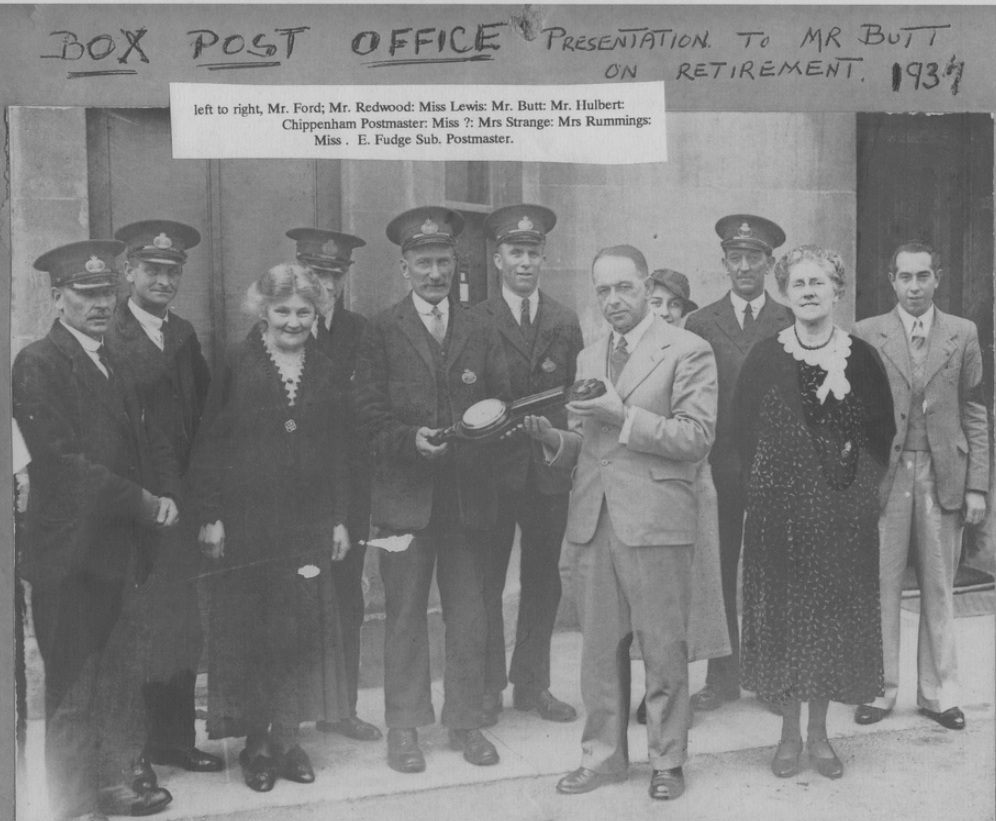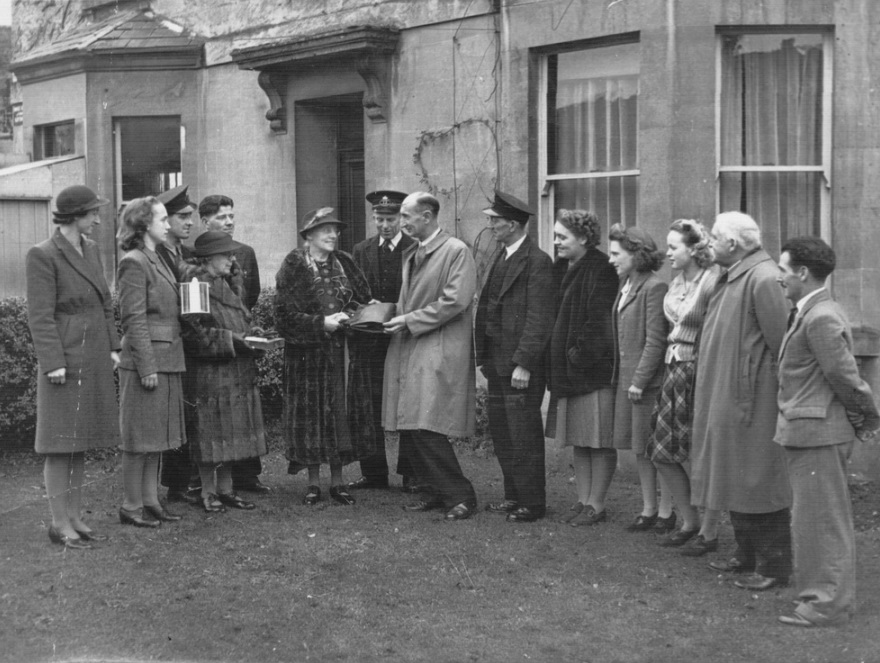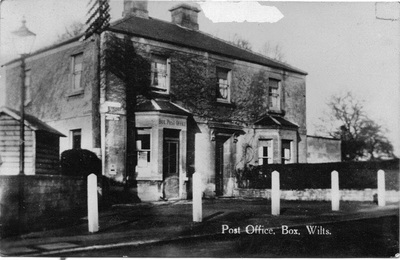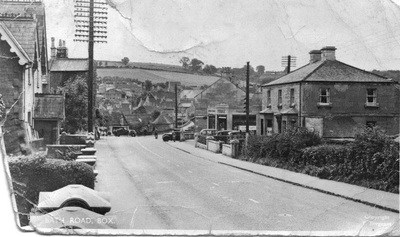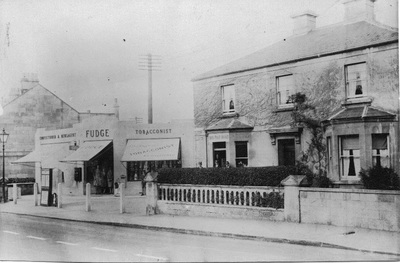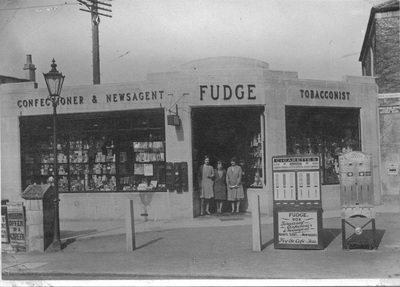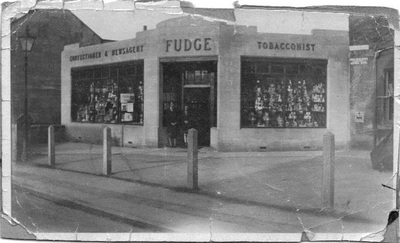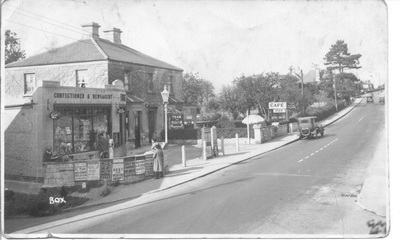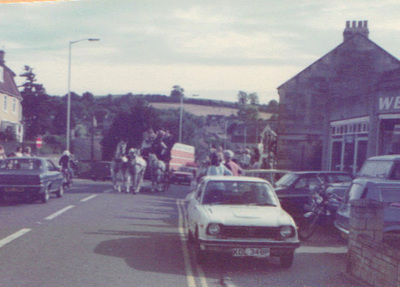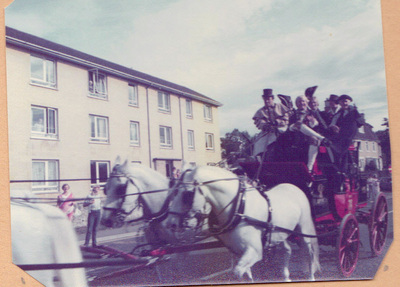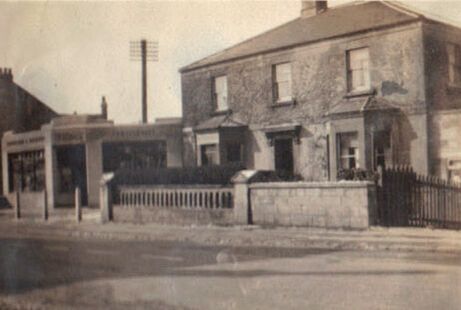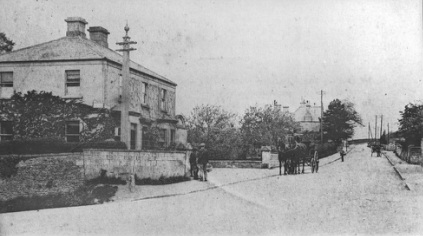
Post Office at Box
Ronnie Walker
Reproduced from Box Parish Magazine, July 2004
All photos and addition of family details courtesy of Patty Baldwin.
Other contributions Alan Clench and Chris Cunningham
Left: The earliest photo of the Post Office dates from 1920s
Ronnie Walker
Reproduced from Box Parish Magazine, July 2004
All photos and addition of family details courtesy of Patty Baldwin.
Other contributions Alan Clench and Chris Cunningham
Left: The earliest photo of the Post Office dates from 1920s
The Post Office History
The Roman Empire had a postal service called the Cursus Publicus, but it was reserved for government use. Here in England during the middle ages, special tradesmen were stationed at posts about twenty miles apart along a few important routes to carry messages in relays. But it was not until 1635 in Great Britain that the Royal Mail was made available for private letters. The cost of postage was high and it was usually the recipient who was asked to pay. As the charge was per sheet, writers usually wrote on three sides of a folded page and addressed it on the fourth side. The sheet was then folded and fastened with sealing wax.
There were no deliveries to specific addresses until William Dockwra introduced the local penny post in 1680 in London. This consisted of a charge of one penny for local deliveries and was added to the general post charges for letters from other towns. The penny post was paid in advance and in those days a penny was a lot of money. By 1812 it cost 13 pence to send a letter from London to Edinburgh, despite the use of special Mail Coaches, introduced by John Palmer of Bath in 1784. The mail coaches had an armed guard and had free transit through the toll gates. When the post horn was heard, all other traffic was set aside, the toll gates were thrown open and the mail coach sped through, often at full gallop. The Bath Road was well maintained and the journey to London took only 16 hours. Mail was first carried by the new railways in 1830 and the next fifteen years saw a dramatic change in the postal system.
Led by the great reformer Rowland Hill, a uniform charge for letters depending on weight and paid for by the sender was introduced. A Dundee bookseller, James Chalmers, suggested little gummed slips of paper to show that the letter had been paid for - and the postage stamp was born. Date stamps were then developed to cancel the postage stamps so they could not be used again.
The Roman Empire had a postal service called the Cursus Publicus, but it was reserved for government use. Here in England during the middle ages, special tradesmen were stationed at posts about twenty miles apart along a few important routes to carry messages in relays. But it was not until 1635 in Great Britain that the Royal Mail was made available for private letters. The cost of postage was high and it was usually the recipient who was asked to pay. As the charge was per sheet, writers usually wrote on three sides of a folded page and addressed it on the fourth side. The sheet was then folded and fastened with sealing wax.
There were no deliveries to specific addresses until William Dockwra introduced the local penny post in 1680 in London. This consisted of a charge of one penny for local deliveries and was added to the general post charges for letters from other towns. The penny post was paid in advance and in those days a penny was a lot of money. By 1812 it cost 13 pence to send a letter from London to Edinburgh, despite the use of special Mail Coaches, introduced by John Palmer of Bath in 1784. The mail coaches had an armed guard and had free transit through the toll gates. When the post horn was heard, all other traffic was set aside, the toll gates were thrown open and the mail coach sped through, often at full gallop. The Bath Road was well maintained and the journey to London took only 16 hours. Mail was first carried by the new railways in 1830 and the next fifteen years saw a dramatic change in the postal system.
Led by the great reformer Rowland Hill, a uniform charge for letters depending on weight and paid for by the sender was introduced. A Dundee bookseller, James Chalmers, suggested little gummed slips of paper to show that the letter had been paid for - and the postage stamp was born. Date stamps were then developed to cancel the postage stamps so they could not be used again.
|
At last on 6th May 1840 the universal penny post was started using the famous Penny Black and a modern postal system was invented, which eventually spread all over the world. In 1846 a mail coach left London for the last time. In the 1850s pillar boxes were introduced and home deliveries were started. From then on the postal system was refined, speeded up in numerous ways, but it was all based on the original ideas of Rowland Hill. Only in the last few decades has a major new technique challenged this tradition with the development of e-mail.
In 1764 the law was changed to allow local penny post deliveries to be made in any area of Britain. |
Box Post Office
It is not known when the first Post Office was established in Box, but it is on record that in 1814 Box was No.9 in the Bath penny post deliveries and in 1824, it became No.9 in the Chippenham penny post. In 1865 Box Post Office was authorised to handle money orders and Post Office Savings Bank business and in 1875 it had its own telegraph office.
Some few years later, a linen draper in Box, called Mr John (often known as James) Fudge, took over the Post Office from Mr Charles Hardy, who had been the postmaster for the previous 20 years. Mr Fudge appears to have had a draper's shop in the Market Place next to Bence's, or it may have been the precursor of Bence's. In 1871 he is described as Draper and Assistant Overseer. According to family memory James Fudge died young. This is borne out by the records which show Mrs Sarah Fudge, his widow, as sub postmistress in charge of Box Post Office in 1885.
Between 1881 and 1891 Mrs Sarah Fudge acquired the present post office building including the land stretching all the way up to the railway line.[1] The house had been built for a Lt.Col Northey in 1832 before the coming of the railway and before the London road was built. Between the ownerships of Col Northey and Mr Jack Fudge, it had been used for various businesses, the last a tailor's shop.[2] The post office was moved from the Market Place by 1891 and in due course the room behind the present public office became the village telephone exchange.
Sarah's daughter Miss Esther M Fudge took over in 1911 and remained sub postmistress for the next 36 years. Esther and her sister Leonorah had a long training in postal work. In October 1899 they were described as learners in the work; in 1903 Leonora ws nominated as SCT Chippenham. Postal service was in the family blood. Although he was never sub postmaster at Box, Mr Jack Fudge, Richard's father, was also influential in Box postal affairs. He held a responsible position at Chippenham Post Office and at times probably was able to assist his sister Esther at Box.
Throughout this period new technology was coming in and Esther trained as an Exchange Attendant at Box in September 1912. There were a number of alterations during Esther's time. The back room of the Post Office house was converted to be the telephone exchange and the shop was built next door in about the 1930s. Esther eventually retired in 1947 and was duly commemorated for her service by the Post Office.
It is not known when the first Post Office was established in Box, but it is on record that in 1814 Box was No.9 in the Bath penny post deliveries and in 1824, it became No.9 in the Chippenham penny post. In 1865 Box Post Office was authorised to handle money orders and Post Office Savings Bank business and in 1875 it had its own telegraph office.
Some few years later, a linen draper in Box, called Mr John (often known as James) Fudge, took over the Post Office from Mr Charles Hardy, who had been the postmaster for the previous 20 years. Mr Fudge appears to have had a draper's shop in the Market Place next to Bence's, or it may have been the precursor of Bence's. In 1871 he is described as Draper and Assistant Overseer. According to family memory James Fudge died young. This is borne out by the records which show Mrs Sarah Fudge, his widow, as sub postmistress in charge of Box Post Office in 1885.
Between 1881 and 1891 Mrs Sarah Fudge acquired the present post office building including the land stretching all the way up to the railway line.[1] The house had been built for a Lt.Col Northey in 1832 before the coming of the railway and before the London road was built. Between the ownerships of Col Northey and Mr Jack Fudge, it had been used for various businesses, the last a tailor's shop.[2] The post office was moved from the Market Place by 1891 and in due course the room behind the present public office became the village telephone exchange.
Sarah's daughter Miss Esther M Fudge took over in 1911 and remained sub postmistress for the next 36 years. Esther and her sister Leonorah had a long training in postal work. In October 1899 they were described as learners in the work; in 1903 Leonora ws nominated as SCT Chippenham. Postal service was in the family blood. Although he was never sub postmaster at Box, Mr Jack Fudge, Richard's father, was also influential in Box postal affairs. He held a responsible position at Chippenham Post Office and at times probably was able to assist his sister Esther at Box.
Throughout this period new technology was coming in and Esther trained as an Exchange Attendant at Box in September 1912. There were a number of alterations during Esther's time. The back room of the Post Office house was converted to be the telephone exchange and the shop was built next door in about the 1930s. Esther eventually retired in 1947 and was duly commemorated for her service by the Post Office.
Esther's nephew Mr Richard Fudge took over from her when he returned from war service in 1947. Richard was a parish councillor, district councillor, council chairman
and had 36 years in the Post Office. Finally when Richard retired in 1983 the Fudge Postal Dynasty of Box came to an end having survived for more than 100 years.
In 1885 there were letter boxes at Middlehill, Ashley and Boxhill. By 1911 the demand for postal service had justified post offices in addition to Box PO, at Ashley, Kingsdown and Boxhill, each with its own sub postmaster. Village post offices had been private ventures licensed out to individual shopkeepers almost from the beginning. After the 1914-18 war, with the development of public transport, the demand for local small offices fell away and postal services were concentrated in the Box Post Office as it is today.
The manual telephone exchange is long gone due to new technology and centralisation. The stationers' business which Esther Fudge brought with her has moved on. Almost ever since the start of old age pensions in 1911, collecting them at the village post office has been almost a social occasion, but now this also is threatened by new technology and centralisation. Village sub postmasters depend on the commission which the General Post Office pays on all the transactions they undertake and central government employs the GPO to distribute limited services. As more of these facilities are centralised the resultant reduction in commission revenue may close many village post offices. Let us hope this never includes the catastrophe of losing our Box Post Office.
The manual telephone exchange is long gone due to new technology and centralisation. The stationers' business which Esther Fudge brought with her has moved on. Almost ever since the start of old age pensions in 1911, collecting them at the village post office has been almost a social occasion, but now this also is threatened by new technology and centralisation. Village sub postmasters depend on the commission which the General Post Office pays on all the transactions they undertake and central government employs the GPO to distribute limited services. As more of these facilities are centralised the resultant reduction in commission revenue may close many village post offices. Let us hope this never includes the catastrophe of losing our Box Post Office.
Shop, Cafe and Sorting Office
The shop and the cafe next door were later additions. There was a sorting office at the back of the shop. Mail came to Box Halt and was taken for sorting here, which is why so many people worked in Box Post Office. The entrance to the sorting room was through the back of the shop for security.
The shop and the cafe next door were later additions. There was a sorting office at the back of the shop. Mail came to Box Halt and was taken for sorting here, which is why so many people worked in Box Post Office. The entrance to the sorting room was through the back of the shop for security.
Centenary Celebrations 1984
A mail coach retraced the old postal service through the centre of the village.
Emma Doughty (nee Jones) added:
The photos of the mail coach in 1984 - Chris Tarrant (can't remember the name of the other chap) drove from Bristol to London, stopping in Corsham (at the Hare and Hounds) to change horses. I remember the TV documentary where they talked about Box Hill being the hardest part of the whole journey as it was so long and steep. We watched them go by from opposite the paper shop/post office.
A mail coach retraced the old postal service through the centre of the village.
Emma Doughty (nee Jones) added:
The photos of the mail coach in 1984 - Chris Tarrant (can't remember the name of the other chap) drove from Bristol to London, stopping in Corsham (at the Hare and Hounds) to change horses. I remember the TV documentary where they talked about Box Hill being the hardest part of the whole journey as it was so long and steep. We watched them go by from opposite the paper shop/post office.
Postmasters at Box Post Office
References
[1] Alan Clench adds that Lycetts Orchard was so named because it was the orchard for the Post Office. All the houses up the road, including Lorne House and the present doctors' surgery, were created as individual plots sold by the Fudge family.
[2] Patty Baldwin (nee Fudge) adds that the Post Office is listed as being in the Market Place in the 1891 census but had moved to the High Street by 1901. It may have originally been in the Draper's shop next to the Chequers.
[1] Alan Clench adds that Lycetts Orchard was so named because it was the orchard for the Post Office. All the houses up the road, including Lorne House and the present doctors' surgery, were created as individual plots sold by the Fudge family.
[2] Patty Baldwin (nee Fudge) adds that the Post Office is listed as being in the Market Place in the 1891 census but had moved to the High Street by 1901. It may have originally been in the Draper's shop next to the Chequers.
